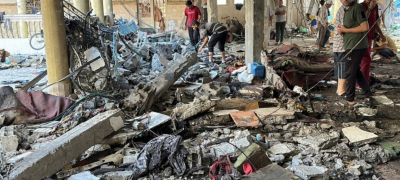RAFAEL GROSSI , director-general of the International Atomic Energy Agency, warned that North Korea’s nuclear weapons program has expanded “exponentially” and that the international community has no visibility on it. He said the problem needs presidential-level diplomacy to tackle it.
“You cannot have a country like this, which is completely off the charts with this nuclear arsenal, … with such a big nuclear program, with all these facilities, without us having any clue of any safety or security measures which are being applied to it,” Grossi sad at a Council on Foreign Relations event in Washington today.
Read more: Korea-Pakistan Cultural Ties Strengthen at NUML’s Soft Power Seminar 2025
The stark warning underscores how alarmed the nuclear nonproliferation world is with North Korea’s weapons program — even as Washington’s eyes are focused on Iran’s nuclear talks today.
Grossi suggested that Trump should re-engage with North Korean leader KIM JONG UN directly to tackle the growing problem.
“I know that for some — and I understand, I have great respect for them — it’s only ‘they disarm or we don’t talk.’ Well, unfortunately, things are a bit more complicated in international life, and you’re not going to get everything you want, especially when a country has acquired such a big nuclear arsenal,” he said of talks with North Korea.
“Presidential diplomacy is important,” he said, citing what Trump called his “love letters” to Kim during his first administration ahead of his summits with the North Korean leader. Those talks ended at an impasse.
No country formally recognizes North Korea as part of the privileged club of states with nuclear weapons, a tier in international diplomacy held by the likes of the United States, Russia, China and France.
But not so secretly, North Korea has amassed a significant arsenal of nuclear weapons despite crushing international sanctions. North Korea has anywhere from 30 to 50 nuclear warheads and enough fissile material for 70 to 90 nuclear weapons, according to data from the Arms Control Association and Center for Arms Control and Non-Proliferation . Iran, by comparison, is sitting on the cusp of a nuclear breakout but has no plans yet to take the leap and actually build a nuclear weapon, according to publicized U.S. intelligence assessments.
The Biden administration’s approach to North Korea was opening the door for talks anywhere, anytime, without any preconditions. North Korea responded by effectively ghosting them for four years. Now the problem is Trump’s.
So far, we haven’t seen any appetite from Trump to restart North Korea talks that, during his first term, were a fixture of his foreign policy agenda. To be fair, his administration has a lot on its plate between Ukraine, the Mideast, China and efforts to sort out its other big nuclear proliferation headache, Iran.
But North Korea is steadily increasing its nuclear capabilities and expanding its arsenal of long-range missiles that could deliver those nuclear warheads, and leading nations are taking note. In 2023, Japan assessed that North Korea had built a homegrown intercontinental ballistic missile that could reach the U.S. homeland . Each missile test they conduct, failed or not, inches them closer to more capable missiles. Grossi at CFR also said North Korea already has one nuclear enrichment facility and is working on a second and potentially third.
Another headache here the Trump administration has to grapple with is the Russia factor. Russia’s security ties with North Korea have blossomed in recent years as it exchanges military technology and know-how with the hermit kingdom in exchange for sending North Korean troops and ammunition to shore up its frontlines in Ukraine.





